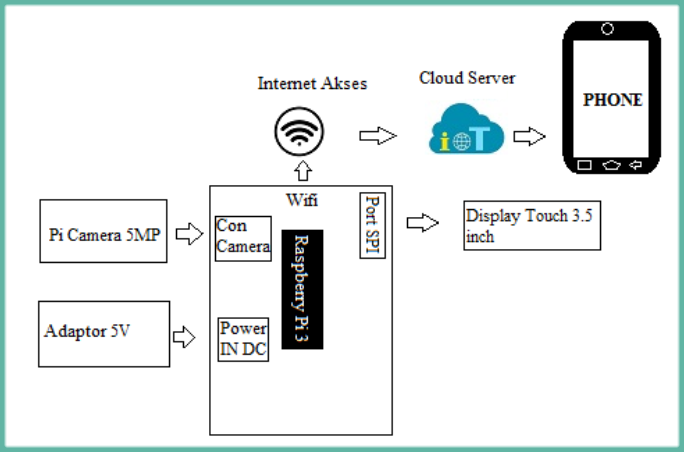New Student Drug Tests at College Using Principal Component Analysis Method
DOI:
https://doi.org/10.25299/itjrd.2022.7583Keywords:
Face Detection, Drugs, Principal Component Analysis, CollegeAbstract
Drugs are substances or illegal drugs that can endanger human life. Someone who consumes it in an inappropriate way will become dependent and even result in death. The physical characteristics of people who use drugs vary, but the more obvious characteristics are on the faces of drug users such as red eyes, stiff facial muscles, dark spots, pupils susceptible to light, sunken face shape, and dullness. The lack of physical characteristics of drug users due to similarities with other diseases makes it difficult for people to recognize them initially. However, for users whose face data has been tracked by the National Narcotics Agency, the facial data is stored in the dataset. This research was conducted with the aim of building a system that can detect and recognize prospective students whether they have ever been included in drug users recorded in the National Narcotics Agency dataset or not as one of the requirements for new student admissions to universities. The system built using the Principal Component Analysis method to process and extract images of the physical characteristics of drug users through the facial image data of drug users stored in the dataset. If the detected face has similarities with the characteristics in the dataset, it is necessary to suspect that the detected face is a drug user. The results of this study are the system is able to detect the faces of drug users using the Principal Component Analysis method with an accuracy of 90% and it is hoped that with this research the system can be one solution in helping universities as an identification effort to minimize drug use so that it can be an additional identification tool which strengthens someone detected using drugs.
Downloads
References
BP Hariyanto, "Prevention and Eradication of Drug Trafficking in Indonesia," J. Sovereign Huk., vol. 1, no. 1, pp. 201–210, 2018.
C. Suhery and I. Ruslianto, "Human Face Identification for Lecture Attendance Monitoring System using Principal Component Analysis (PCA) Feature Extraction," J. Education and Researchers. information., vol. 3, no. 1, pp. 9–15, 2017.
Susanti, M. Azmi, E. Ali, Rahmaddeni, and YS Wijaya, "Comparison of Boolean Model and Vector Space Model in Searching Text Documents," digits. Zo. J. Teknol. inf. commune., vol. 11, no. x, pp. 268–277, 2020.
S. Monika, A. Rakhman, and Lindawati, "HOUSE SECURITY WITH FACE RECOGNITION SYSTEM IN REAL TIME USING PRINCIPAL COMPONENT ANALYSIS METHOD," Pros. 4th SNATIF, pp. 395–401, 2017.
KD Septian, SJI Ismail, and A. Sularsa, "Prototype of a Face Recognition Security System Based on Principal Component Analysis (Pca)," e-Proceeding Appl. science., vol. 5, no. 2, pp. 1340–1349, 2019.
A. Zein, "MULTI FACE DETECTION AND RECOGNITION IN REAL TIME USING PRINCIPAL COMPONENT ANALYSIS (PCA) AND EIGENFACE METHODS," Technol. inf. ESIT, vol. XII, no. 1, pp. 1–7, 2018.
A. Budi, Suma'inna, and H. Maulana, “Recognition of Facial Image as Identifier Using Principal Component Analysis (PCA) Method,” vol. 9, no. 2, pp. 166–175, 2016.
MA Prastya, "HUMAN FACE RECOGNITION SYSTEM USING VIOLA-JONES ALGORITHM AND PRINCIPAL COMPONENT ANALYSIS," Ubiquitous Comput. its Apps. J., vol. 2, pp. 85–92, 2019.
H. Himmah, B. Hidayat, and F. Oscandar, "INDIVIDUAL IDENTIFICATION BASED ON LIVER PRINT PATTERNS WITH PRINCIPAL COMPONENT ANALYSIS AND RADIAL BASE FUNCTION FOR FORENSIC APPLICATIONS," e-Proceeding Eng., vol. 5, no. 1, pp. 469–479, 2018.
A. Darmawan, “Real-Time Face Recognition Mobile Application Based on Principal Component Analysis,” Ubiquitous Comput. its Apps. J., vol. 2, no. 1, pp. 57–66, 2019.
H. Dafitri, MS Asih, and RI Astuti, "Interactive Media for Recognizing Numbers with Fingers Using the PCA (Principal Component Analysis) Method," Query J. Sist. inf., vol. 3, no. 2, pp. 57– 65, 2019.
A. Hanuebi, S. Sompie, and F. Kambey, “Face Recognition Application to Open Doors Based on Raspberry Pi,” Tech. information., vol. 14, no. 2, pp. 243–252, 2019.
N. Kustian, "PRINCIPAL COMPONENT ANALYSIS FOR FACE RECOGNITION SYSTEMS USING EIGENFACE METHOD," J. String, vol. 1, no. 2, pp. 193–202, 2016.
Salamun and F. Wazir, "DESIGNING FACE RECOGNITION SYSTEM WITH PRINCIPAL COMPONENT ANALYSIS METHOD," RABIT J. Teknol. and Sis. inf. UNIVRAB, vol. 1, no. 2, pp. 61–77, 2016.
YB Muhammad Rizki Muliawan, Beni Irawan, "Implementation of Face Recognition Using the Eigenface Method in the Attendance System," J. Coding, Sis. computer. camel, vol. 3, no. 1, pp. 41–50, 2015.

Downloads
Published
How to Cite
Issue
Section
License
This is an open access journal which means that all content is freely available without charge to the user or his/her institution. The copyright in the text of individual articles (including research articles, opinion articles, and abstracts) is the property of their respective authors, subject to a Creative Commons CC-BY-SA licence granted to all others. ITJRD allows the author(s) to hold the copyright without restrictions and allows the author to retain publishing rights without restrictions.















